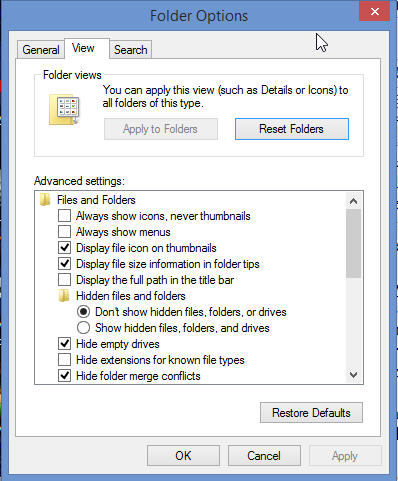Unhide Your File Extensions
By Wayne Maruna

There
are many things that Microsoft does that I do not understand.
Most of these are technical in nature, but one non-technical thing they
do just defies logic for me, and that is to hide file extensions by
default. Before you mumble ‘What’d he say?’ and tune out,
let me explain.
The term file extension is shorthand for file
name extension. Every file in a Windows system has a name, e.g. 'Our
Spending Summary' or 'Capital Humane' or 'BBQ in Bluejeans'. But for
Windows to have some idea as to what sort of content is in the file and
what program it should use to open the file, the filename has to have
an extension. So the
rules are that the filename must end in a period followed by three
alpha characters from a pre-defined long list of standard
extensions. So those file names above may actually be 'Our
Spending Summary.xls', 'Capital Humane.pdf', and 'BBQ in Bluejean.doc'.
Windows will use a default program to handle each file type. For
example, it most often would open an XLS file with Microsoft Excel, a
DOC file with Microsoft Word, and a PDF file with Adobe Acrobat
Reader. The defaults may vary from machine to machine depending
on the software installed, but in any case, Windows has a default
program associated with every file type on every machine.
On my
computers, you can open up Windows File Explorer and see file names and
their extensions. But on most machines, you will not see the
extensions unless someone has told the machine to show them.
That’s because Microsoft has decided that by default all Windows
machines are delivered with file extensions hidden. Why they do
this, I do not know; it makes no sense to me. Instead, they may
give you a hint by putting the associated program’s icon in front of
the file name in Windows Explorer (recently renamed File Explorer in
newer versions of Windows). That’s fine, but the icons are the
size of dandruff flakes, and are even more incomprehensible to the
average person than those ‘universal’ markings on elevator door
controls.
If I have ever been called to work on your computer,
rest assured that your machine now shows filename extensions by
default, because I always make sure they are set that way. You may ask
why this is important. For one thing, a better educated computer user
is a more skilled user, but more importantly, hackers are using this
hidden file extension setting to advance their exploits.
One
common and very powerful file extension is ‘EXE’. This stands for
‘Executable’ and means that when double clicked, the file will carry
out a set of instructions. That’s good if the instructions are to
open your tax program and prepare it for entry. That’s bad if the
instructions tell the system to lock all your files or generate a
steady stream of pop-ups. Hackers know that their best chance for
delivering a nefarious payload is to do it surreptitiously. So they
send you a file named ‘Cute Kitty.jpg’. A JPG file is designed to
contain a picture of some sort. But what if you have file
extensions hidden, and the real name of the file is ‘Cute
Kitty.jpg.exe’? It is the extension after the last period that is the
real file extension. So which file are you more likely to open?
‘Cute Kitty.jpg’, right? If your file extensions are hidden, you don’t
even know that ‘.exe’ is there and ready to bring down the hammer.
 The
good news is that if your file extensions are hidden, they are easy to
unhide. The method will vary a bit depending on your version of
Windows. If you are still running XP, open My Computer, click on
Tools, Folder Options, and click on the view tab. Look down the
column for ‘Hide extensions for Known File Types’ and uncheck it.
The
good news is that if your file extensions are hidden, they are easy to
unhide. The method will vary a bit depending on your version of
Windows. If you are still running XP, open My Computer, click on
Tools, Folder Options, and click on the view tab. Look down the
column for ‘Hide extensions for Known File Types’ and uncheck it.
If
you are running Windows Vista or Windows 7, open ‘Computer’ and click
on Organize, then Folder and Search Options. In the next window,
click on the View tab, look for the line that reads ‘Hide Extensions
for Known File Types’ and uncheck it.
If you have made the move
to Windows 8, your path is slightly different (gee, that’s a surprise.)
Go to the Control Panel, click on Appearance and Personalization, Then
on Folder Options. Click on the View tab, and look for the line
that reads ‘Hide Extensions for Known File Types’ and uncheck it.
It’s
little wonder that people get frustrated with Microsoft. We’ve
just seen a perfect example of how they are constantly changing the way
to do the simplest of tasks, seemingly creating change just for the
sake of change. Ah, but that is a rant for another time.
There’s nothing immodest about un-hiding your file extensions. It’s a smart thing to do.

 The
good news is that if your file extensions are hidden, they are easy to
unhide. The method will vary a bit depending on your version of
Windows. If you are still running XP, open My Computer, click on
Tools, Folder Options, and click on the view tab. Look down the
column for ‘Hide extensions for Known File Types’ and uncheck it.
The
good news is that if your file extensions are hidden, they are easy to
unhide. The method will vary a bit depending on your version of
Windows. If you are still running XP, open My Computer, click on
Tools, Folder Options, and click on the view tab. Look down the
column for ‘Hide extensions for Known File Types’ and uncheck it.